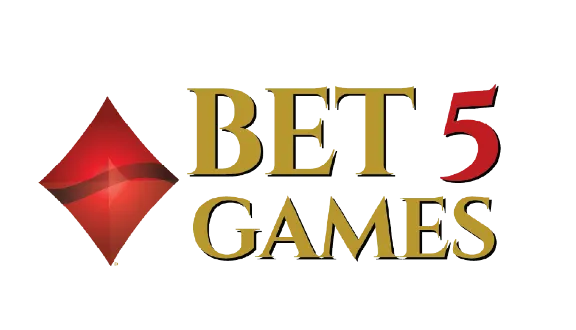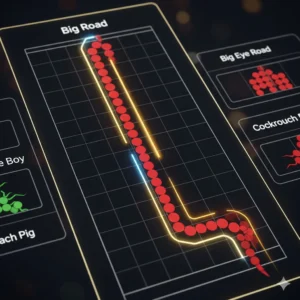An Analyst’s Introduction: The Heart of Baccarat Pattern Tracking
Welcome to the analyst’s desk. In the elegant game of baccarat, the flow of cards tells a story. While many scoreboards exist to record this story, one stands above the rest as the heart of all pattern analysis: The Big Road. It is the canvas where streaks are born, where trends become visible, and where the legendary “dragon” takes flight.
This is more than a simple guide; it is a masterclass. Our objective is to take you beyond a surface-level understanding and provide you with an analyst’s method for deconstructing the Big Road. You will learn not just how it is built, but how to interpret its patterns, understand its relationship with all other roads, and use it as a tool for a more disciplined and informed game.
However, a true analyst always begins with a foundation of truth.
A Crucial Disclaimer on Strategy: The Gambler’s Fallacy
Let us be perfectly clear: The Big Road is a flawless historian, but it is not a psychic. It meticulously records the past but cannot predict the future. Every hand of baccarat is a statistically independent event. The belief that a long streak of Banker wins makes a Player win “due” is a powerful cognitive bias known as the Gambler’s Fallacy. The first rule of analysis is to respect the mathematics of the game. We are here to master historical analysis, not to chase impossible certainties.
What You Will Master in This Guide
In this masterclass, we will systematically deconstruct the entire Baccarat Roads system, using the Big Road as our central point of focus. You will learn how the Big Road is built, how to read its core patterns, and how it serves as the parent to the more abstract “derived roads.” By the end, you will view the baccarat scoreboard not as a confusing grid, but as a clear narrative of the shoe.
The Foundation: From Bead Plate to Big Road
To understand the Big Road, you must first know where its data comes from. All pattern analysis begins with one simple, chronological record.
A Quick Recap: The Bead Plate’s Raw Data
The Bead Plate is a raw, sequential log of every hand played. It records the outcome of each hand (Banker, Player, or Tie) in the order it occurred, filling a grid cell by cell. It is the unfiltered source of truth. The Big Road takes this raw data and gives it a visual, analytical shape.
Constructing the Big Road: A Step-by-Step Method
The genius of the Big Road lies in how it visualizes streaks. Instead of marking every hand sequentially, a new column is started only when the winning side changes.
The Core Rules:
Starting Point: The first hand (excluding a Tie) is marked in the top-left cell of the grid. Let’s say it’s a Banker win. We place a hollow Red circle there.
Continuing a Streak: If the next hand is also a Banker win, we place another Red circle directly below the first one in the same column. We continue down the column as long as the Banker streak continues.
Changing the Winner: As soon as the streak is broken by a Player win, we move one column to the right and start a new column with a single hollow Blue circle.
This simple method immediately turns raw data into a powerful visual. A long vertical column screams “streak,” while a series of short columns indicates a back-and-forth, “choppy” game.
How to Correctly Mark Ties and Pairs:
Ties: A Tie does not get its own circle and does not break a streak. It is marked as a green slash across the most recent circle drawn. If two Ties occur in a row, a small “2” is placed next to the slash.
Pairs: A Banker Pair is marked with a small red dot on the top-left edge of the circle. A Player Pair is marked with a small blue dot on the bottom-right edge of the circle.
Reading the Big Road: Identifying Key Patterns
Once you understand how the Big Road is built, you can begin to read its language. Players look for several key formations.
The Dragon: Following a Powerful Streak
This is the most famous pattern in baccarat. A “dragon” is a long, uninterrupted streak of wins for either the Banker or the Player. There is no official definition, but most analysts consider a streak of six or more wins to be a dragon. When a dragon appears, the column on the Big Road will extend so long it has to turn right at the bottom of the grid, creating a distinctive tail. The most popular betting strategy associated with this is to “follow the dragon”—betting on the streak to continue until it finally loses.
The Chop: Recognizing a Turn-Based Shoe
The opposite of a dragon is a “chop.” This occurs when the winning side alternates with every hand, creating a pattern of B-P-B-P-B-P. On the Big Road, this looks like a series of single-circle columns, creating a distinct, jagged visual. A choppy shoe is highly unpredictable, and many strategists advise caution or betting on the chop to continue.
Other Common Formations and Trends
Beyond the two extremes, analysts look for smaller, repeating patterns. You might see a “double chop” (BB-PP-BB-PP) or a “two-and-one” pattern (BB-P-BB-P). Recognizing these smaller trends is a sign of an experienced player who is deeply attuned to the flow of the shoe.
The Next Level: How the Big Road Creates the Derived Roads
Mastering the Big Road is essential because it is the “parent” of the three advanced, abstract scoreboards: the Big Eye Boy, the Small Road, and the Cockroach Pig. These derived roads do not show the actual results; they analyze the patterns within the Big Road itself.
The Core Principle: Is the Shoe Patterned or Chaotic?
The purpose of all three derived roads is to answer one simple question: “Is the shoe’s behavior orderly or random right now?” They do this by comparing the latest entry on the Big Road to a previous entry.
A Red Mark on a derived road means Patterned (the shoe is repeating its behavior).
A Blue Mark on a derived road means Chaotic (the shoe is doing something unpredictable).
Deconstructing the Derived Roads
Each derived road performs the same check but looks at a different point in the Big Road’s history:
The Big Eye Boy: Compares the latest entry to the entry one column to its left. It tells you if there’s an immediate pattern.
The Small Road: Compares the latest entry to the entry two columns to its left. It looks for slightly more established patterns.
The Cockroach Pig: Compares the latest entry to the entry three columns to its left. It looks for long-term consistency in the shoe’s behavior.
By looking at the colors on these three roads, an analyst gets a quick, abstract summary of the shoe’s “texture.” A board full of red suggests a predictable shoe, while a board full of blue suggests chaos.
The Analyst’s View: Common Mistakes and Best Practices
Reading the Big Road is an art, but it requires analytical discipline. Here are some key points from an experienced perspective:
Avoid Confirmation Bias: The human brain is designed to see patterns, even in random data. Be wary of convincing yourself a pattern exists when it’s just a short-term statistical anomaly.
Use a Holistic View: Don’t get tunnel vision on just one road. A true analyst synthesizes information from all the scoreboards—the raw count from the Bead Plate, the streaks on the Big Road, and the texture from the derived roads—to form a complete picture.
Know When to Walk Away: Sometimes the most valuable insight the Big Road can give you is that the shoe is too chaotic and unpredictable. The most disciplined players know that the best bet is sometimes no bet at all.
Conclusion: Beyond the Scoreboard
The Big Road is more than a tool for tracking wins and losses; it is the key to visualizing the narrative of the game. It transforms a random sequence of outcomes into a story of streaks, chops, and trends. By mastering the art of reading it, you elevate your understanding of baccarat from a simple guessing game to a practice of strategic observation.
The final step is to use this knowledge with discipline. Use the Big Road to inform your strategy, to manage your bankroll, and to deepen your appreciation for the game’s subtle flows, while always respecting the unassailable laws of probability.

